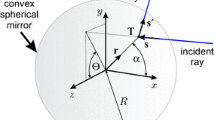Abstract
The objective of the paper was to validate non-linear parametric models of computerised tomography point spread function (PSF), to investigate the role of model parameters and to verify the effect of different imaging conditions on estimated parameters. These models were then to be used experimentally to estimate the variation of PSF shape within the field of view of a scanner. Two parametric models of the PSF are presented. The Gaussian model is appropriate when PSF values are positive, and the damped cosine model can account for negative values. These models are non-linear and fully two-dimensional and do not assume radial symmetry. The models were fitted to images of a point source. The models accounted for over 99% of the variance in the PSF signal. Errors in modulation transfer function were limited to 5% when the appropriate model was selected. The difference in the blurring characteristics of three image reconstruction filters was well quantified by shape parameters, and position parameters located the PSF with subpixel accuracy. With a point source located 50 mm directly above the centre of the field of view, the PSF was found to be anisotropic.
Similar content being viewed by others
References
Barrett, H. H., andSwindell, W. (1981): ‘Radiological imaging. The theory of image formation, detection and processing’, Vol. 2 (Academic Press, New York, 1981)
Bischof, C. J., andEhrhardt, J. C. (1977): ‘Modulation transfer function of the EMI CT head scanner’,Med. Phys.,4, pp. 163–167
Boone, J. M., andSeibert, J. A. (1994): ‘An analytical edge spread function model for computer fitting and subsequent calculation of the LSF and MTF’,Med. Phys.,21, pp. 1541–1545
Boone, J. M. (2001): ‘Determination of the presampled MTF in computed tomography’,Med. Phys.,28, pp. 356–360
Bracewell, R. N. (1977): ‘Correction for collimator width (restoration) in reconstructive x-ray tomography’,JCAT,1, pp. 6–15
Citrin, C. M. (1986): ‘High resolution orbital computed tomography’,JCAT,10, pp. 810–816
Cunningham, I. A., andFenster, A. (1987): ‘A method for modulation transfer function determination from edge profiles with correction for finite element differentiation’,Med. Phys.,14, pp. 533–537
Doré, S., Kearney, R. A., andDe Guise, J. A. (1997b): ‘Experimental correlation-based identification of X-ray CT point spread function. Part II: Simulations and design of input signal’,Med. Biol. Eng. Comput.,35, pp. 9–16
Droege, R. T., andMorin, R. L. (1982): ‘A practical method to measure the MTF of CT scanners’,Med. Phys.,9, pp. 758–760
Glover, G. H., andEisner, R. L. (1979): ‘Theoretical resolution of computed tomography systems’,JCAT,3, pp. 85–91
Glover, G. H., andEisner, R. L. (1980): ‘Correction to theoretical resolution of computed tomography systems’,JCAT,4, p. 108
Goodenough, D. J., Weaver, K. E., andDavis, D. O. (1977): ‘Development of a phantom for evaluation and assurance of image quality in CT scanning’,Opt. Eng.,16, pp. 52–65
Joseph, P. (1981): ‘Artifacts in computed tomography’, inNewton, T. H., andPotts, D. G. (Eds): ‘Radiology of skull and brain. Technical aspects of computed tomography’ (The CV Mosby Company, St-Louis, MO, 1981), pp. 3956–3992
Judy, P. F. (1976): ‘The line spread function and modulation transfer function of a computed tomography scanner’,Med. Phys.,3, pp. 233–236
McIntyre, W. J., Alfidi, R. J., Haaga, J., Chernak, E., andMeany, T. F. (1976): ‘Comparative modulation transfer functions of the EMI and Delta scanners’,Radiology,120, pp. 189–191
Nickoloff, E. L., andRiley, R. (1985): ‘Simplified approach for modulation transfer function determination in computed tomography’,Med. Phys.,12, pp. 437–442
Rathee, S., Koles, Z. J., andOverton, T. R. (1992a): ‘Image restoration in computed tomography: estimation of the spatially variant point spread function’,IEEE Trans. Med. Imag.,11, pp. 539–545
Rathee, S., Koles, Z. J., andOverton, T. R. (1992b): ‘Image restoration in computed tomography: restoration of experimental CT images’,IEEE Trans. Med. Imag.,11, pp. 546–553
Verly, J. G., andBracewell, R. N. (1979): ‘Blurring in tomograms made with x-ray beams of finite width’,JCAT,3, pp. 662–678
Verly, J. G. (1980): ‘X-ray computed tomography in the presence of arbitrary symmetrical focal spot intensity distribution’,Med. Phys.,7, pp. 27–34
Yin, F.-F., Giger, M. L., andDoi, K. (1990): ‘Measurement of the presampling modulation transfer function of film digitizers using a curve fitting technique’,Med. Phys.,17, pp. 962–966
Author information
Authors and Affiliations
Corresponding author
Rights and permissions
About this article
Cite this article
Doré, S., Kearney, R.E. Experimental evaluation of computerised tomography point spread function variability within the field of view: Parametric models. Med. Biol. Eng. Comput. 42, 591–597 (2004). https://doi.org/10.1007/BF02347539
Received:
Issue Date:
DOI: https://doi.org/10.1007/BF02347539




